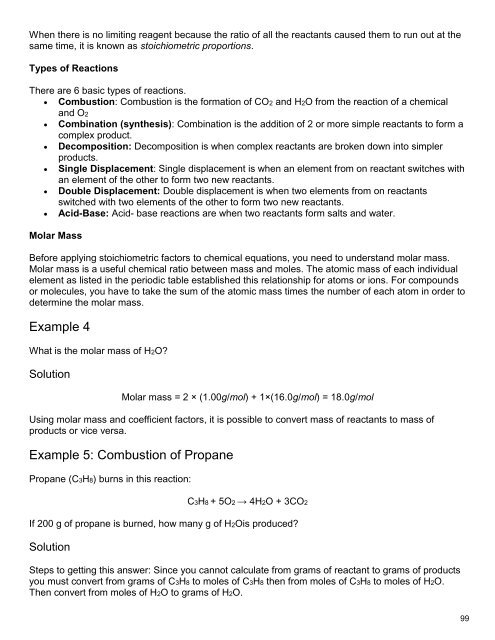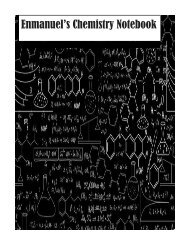Create successful ePaper yourself
Turn your PDF publications into a flip-book with our unique Google optimized e-Paper software.
When there is no limiting reagent because the ratio of all the reactants caused them to run out at the<br />
same time, it is known as stoichiometric proportions.<br />
Types of Reactions<br />
There are 6 basic types of reactions.<br />
Combustion: Combustion is the formation of CO2 and H2O from the reaction of a chemical<br />
and O2<br />
Combination (synthesis): Combination is the addition of 2 or more simple reactants to form a<br />
complex product.<br />
Decomposition: Decomposition is when complex reactants are broken down into simpler<br />
products.<br />
Single Displacement: Single displacement is when an element from on reactant switches with<br />
an element of the other to form two new reactants.<br />
Double Displacement: Double displacement is when two elements from on reactants<br />
switched with two elements of the other to form two new reactants.<br />
Acid-Base: Acid- base reactions are when two reactants form salts and water.<br />
Molar Mass<br />
Before applying stoichiometric factors to chemical equations, you need to understand molar mass.<br />
Molar mass is a useful chemical ratio between mass and moles. The atomic mass of each individual<br />
element as listed in the periodic table established this relationship for atoms or ions. For compounds<br />
or molecules, you have to take the sum of the atomic mass times the number of each atom in order to<br />
determine the molar mass.<br />
Example 4<br />
What is the molar mass of H2O?<br />
Solution<br />
Molar mass = 2 × (1.00g/mol) + 1×(16.0g/mol) = 18.0g/mol<br />
Using molar mass and coefficient factors, it is possible to convert mass of reactants to mass of<br />
products or vice versa.<br />
Example 5: Combustion of Propane<br />
Propane (C3H8) burns in this reaction:<br />
C3H8 + 5O2 → 4H2O + 3CO2<br />
If 200 g of propane is burned, how many g of H2Ois produced?<br />
Solution<br />
Steps to getting this answer: Since you cannot calculate from grams of reactant to grams of products<br />
you must convert from grams of C3H8 to moles of C3H8 then from moles of C3H8 to moles of H2O.<br />
Then convert from moles of H2O to grams of H2O.




